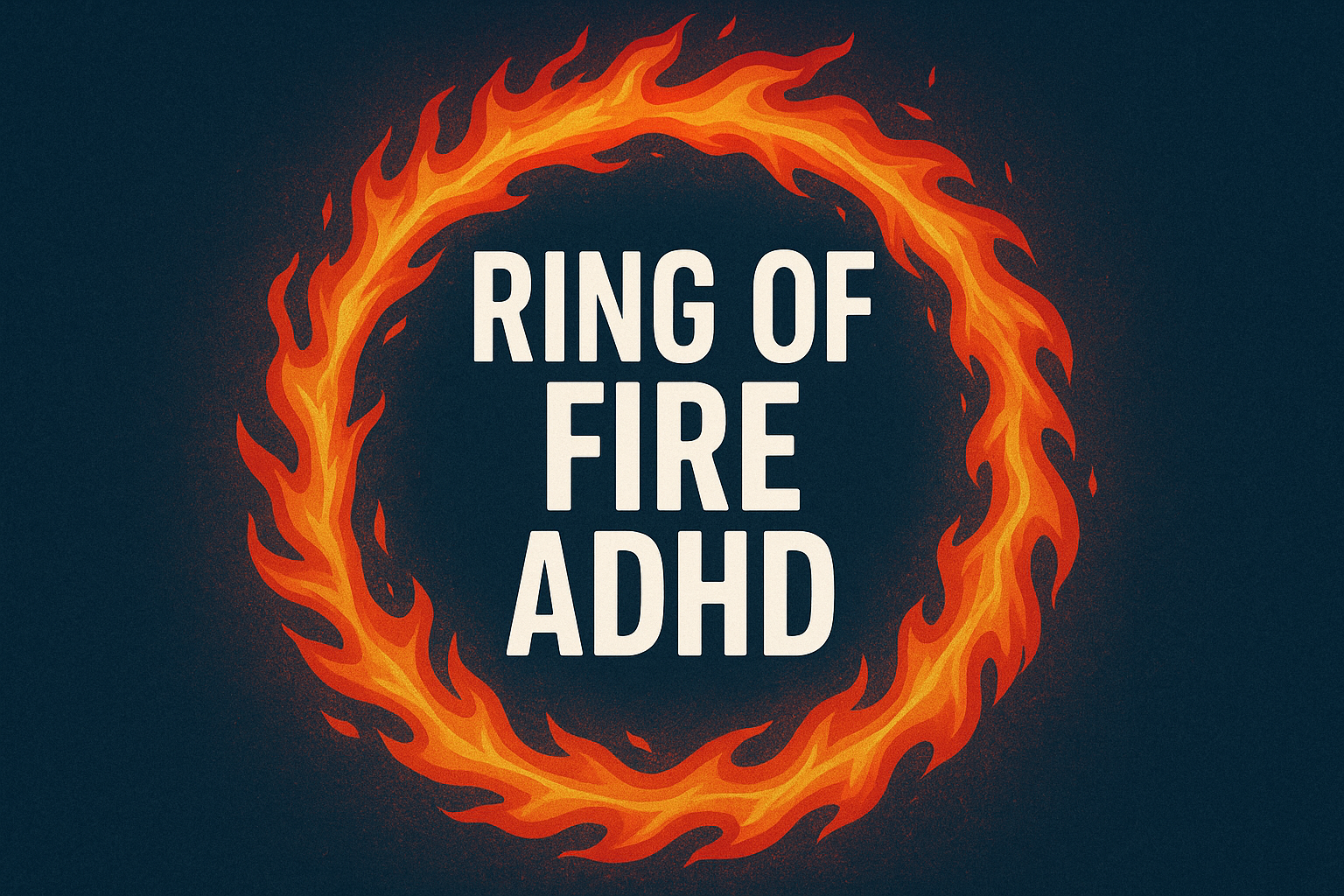What is Ring of Fire ADD?
Is Your Mind Always in Overdrive? You Might Be Facing Ring of Fire ADHD
If you’ve ever felt like your thoughts are moving too fast to catch, your emotions erupt without warning, or your senses feel constantly overstimulated, you’re not imagining things. These experiences can go far beyond typical ADHD traits; they might signal a lesser-known but intensely disruptive subtype known as Ring of Fire ADHD.
Coined by psychiatrist Dr. Daniel Amen, this term describes a specific pattern of ADHD marked by heightened emotional reactivity, mental chaos, and sensory overload. Unlike traditional ADHD types that involve underactivity in the brain, this version shows hyperactivity in multiple regions of the brain, making everything feel amplified.
In 2025, more people than ever are discovering that what they thought was anxiety, mood swings, or even defiance might be part of this misunderstood condition. If you’ve been struggling with symptoms that don’t quite fit the typical ADHD checklist, this guide is for you.
Table of Contents
Let’s explore what Ring of Fire ADHD is and how recognizing it can lead to deeper self-awareness and more effective support.
What Is Ring of Fire ADHD?
Understanding the Lesser-Known ADHD Subtype That Feels Like Mental Overload
If you’ve been diagnosed with ADHD but still struggle with extreme mood shifts, intense emotions, and overstimulation, you might be dealing with something deeper. Ring of Fire ADHD is a distinct subtype that goes far beyond the typical hyperactive or inattentive labels.
A Quick Definition
Ring of Fire ADHD is a form of ADHD marked by emotional intensity, mental hyperactivity, and heightened sensory sensitivity. Unlike traditional ADHD, which often involves underactive brain areas, this type shows excessive activity across multiple regions of the brain.
Where the Term Comes From
This subtype was identified by Dr. Daniel Amen, a psychiatrist known for using SPECT brain imaging to observe patterns in ADHD. His research revealed a unique “ring” of overactivity encircling the brain, hence the name Ring of Fire.
Also Read: ADHD Planner: Unlock Calm, Focus, and Control With This Life-Changing Daily Guide
How It Differs from Other ADHD Types
You’re likely familiar with the common ADHD categories:
- Inattentive Type is mostly distractibility and forgetfulness
- Hyperactive-Impulsive Type: excess energy and impulsiveness
- Combined Typ: a mix of both
But Ring of Fire ADHD presents with more extreme behaviors that often overlap with other mental health conditions, making it harder to recognize and diagnose.
Key Symptoms to Watch For
- Emotional outbursts or volatility that seem unpredictable
- Feeling overwhelmed by noise, crowds, or bright lights (sensory overload)
- Racing thoughts that feel impossible to quiet
- Oppositional or defiant behavior, especially under stress
- Frequent and intense mood swings
These symptoms can lead to frequent misdiagnosis, which is why understanding this ADHD subtype is so crucial.
Source: Dr. Daniel Amen’s ADHD Types – Amen Clinics
The Science Behind the “Ring of Fire” ADHD
Brain Activity, Neuroimaging, and Neurological Insights You Should Know
If you’ve ever wondered why Ring of Fire ADHD feels so intense compared to other types, the answer lies in the brain itself. Thanks to advanced neuroimaging, particularly SPECT scans, researchers have uncovered what’s happening beneath the surface,ce and it’s not what you might expect.
What Is a SPECT Scan and Why Does It Matter?
A SPECT (Single Photon Emission Computed Tomography) scan measures blood flow and activity in different areas of your brain. Unlike traditional brain scans that focus on structure, SPECT scans reveal how your brain functions in real time.
When someone with Ring of Fire ADHD undergoes a SPECT scan, doctors often see a dramatic pattern: overactivity in at least seven distinct brain regions. This circular pattern of hyperactivity resembles a “ring of fire” around the brain, which is how the condition earned its name.
What Areas of the Brain Are Affected?
You experience intense symptoms because this subtype engages multiple areas that control mood, emotion, focus, and behavior, including:
- Limbic system – Regulates emotions; linked to depression and anxiety
- Basal ganglia – Manages impulse control and motor function
- Temporal lobes – Process memory and emotional tone
- Prefrontal cortex – Governs decision-making and attention
When these areas are all simultaneously overactivated, your brain can feel like it’s stuck in overdrive, unable to slow down or filter input.
How This Overactivity Translates Into Symptoms
This intense neurological activity leads to symptoms like:
- Emotional hypersensitivity
- Sensory overwhelm
- Impulsivity and reactivity
- Difficulty calming your thoughts or focusing
These symptoms often cause you to feel constantly “on edge,” making daily tasks and relationships more challenging than they are for others with typical ADHD.
Tip: If possible, include a SPECT scan image of the Ring of Fire ADHD pattern from Amen Clinics or another verified medical source to reinforce credibility and visual understanding.
Ring of Fire ADHD Symptoms Checklist
Is This You or Someone You Know?
When you live with Ring of Fire ADHD, the signs aren’t always subtle. You might find that everyday situations trigger reactions that feel disproportionate, even exhausting. If you’re unsure whether this description fits, use the checklist below to evaluate whether these emotional and behavioral symptoms resonate with your experience.
Common Emotional and Behavioral Symptoms of Ring of Fire ADHD
Do any of these feel familiar?
- You get easily frustrated or irritated, even by minor inconveniences.
- Mood swings hit you without warning, swinging from high energy to emotional shutdown.
- You often argue or challenge authority, especially when feeling misunderstood or pressured.
- Your environment overwhelms you—bright lights, loud sounds, or crowded spaces can quickly drain your energy.
- Your mind overheats from intense focus, making it hard to relax, switch tasks, or fall asleep.
These symptoms are more than personality quirks. They’re part of a pattern that reflects overactivation across multiple brain regions, as seen in those with Ring of Fire ADHD.
If several of these traits describe your daily experience or someone close to you, it’s time to consider a deeper evaluation. Recognizing the pattern is the first step toward managing it effectively.
Cognitive Signs of Ring of Fire ADHD
Your brain might feel like it’s firing in every direction at once. These cognitive symptoms of Ring of Fire ADHD can make it hard to think, stay present, or complete tasks, despite your intelligence and intentions.
Ask yourself:
- Do your thoughts race constantly, making it difficult to slow down, focus, or fall asleep?
- Is impulse control a daily challenge, whether you’re interrupting, overspending, or reacting without thinking?
- Do you swing between hyperfocus and distraction, where you’re locked into one task for hours, then unable to concentrate the next?
This push-and-pull between mental overdrive and executive dysfunction is a hallmark of Ring of Fire ADHD. You’re not lazy or undisciplined, your brain is simply working in a way that demands a different kind of support and strategy.
Physical Symptoms You Shouldn’t Ignore
While ADHD is often seen as a mental health condition, Ring of Fire ADHD can manifest in your body, too. These physical signs are commonly overlooked but play a big role in how this subtype affects your daily life.
Ask yourself if you experience:
- Trouble sleeping, even when you feel exhausted, your mind refuses to shut down.
- Constant movement or restlessness, you might fidget, pace, or feel unable to sit still for long.
- Digestive issues or body tension, such as stomach pain, headaches, or muscle tension, are often triggered by emotional stress or overstimulation.
These somatic complaints aren’t all in your head. They’re part of the overstimulated state your nervous system is operating in due to heightened brain activity.
If your body is just as reactive as your mind, it may be time to explore strategies tailored specifically to Ring of Fire ADHD, not just general ADHD symptoms.
How ADHD Glasses Help Improve Focus and Reduce Sensory Overload? Comprehensive Guide
What Causes Ring of Fire ADHD?
A Mix of Genetic, Environmental & Neurological Factors
You might be wondering why your ADHD symptoms feel so intense compared to others. The answer likely lies in a complex mix of genetics, environment, and brain chemistry. Unlike typical ADHD, Ring of Fire ADHD is driven by overactivity, and that overactivity doesn’t come out of nowhere.
Here’s a closer look at what might be behind it:
Genetic Predisposition
If ADHD or mood disorders run in your family, you could be more prone to this subtype. Research shows that genetic factors influence both the intensity and expression of ADHD symptoms, especially when paired with emotional dysregulation.
- A parent or sibling with ADHD
- Family history of anxiety, depression, or bipolar disorder
- Early childhood behavioral issues
Environmental Triggers That Can Activate or Worsen Symptoms
Your surroundings and experiences can amplify how Ring of Fire ADHD shows up in your life. Even if you’re genetically predisposed, certain environmental stressors may tip the balance.
- Chronic stress or unresolved trauma (e.g., bullying, neglect, emotional abuse)
- Diet-related inflammation, especially from processed foods or artificial additives
- Toxins like mold, lead, or heavy metals that disrupt brain chemistry
- Highly stimulating or chaotic environments that increase sensory overload
Brain Chemistry and Inflammation
Many people with this subtype show signs of neuroinflammation or chemical imbalances, especially elevated glutamate levels, a neurotransmitter linked to overstimulation. These chemical shifts may trigger excessive neural activity and emotional volatility.
You may also have higher levels of inflammatory markers, which can affect your mood, focus, and even digestion.
Food Sensitivities and ADHD
Certain foods can act like triggers, especially if you have sensitivities to gluten, dairy, soy, or artificial colors. These can cause inflammation in the gut-brain axis, worsening symptoms like:
- Brain fog
- Mood swings
- Sleep disruption
- Digestive discomfort
If you’ve ever noticed your symptoms spike after certain meals, your body might be reacting to foods your brain can’t tolerate well.
ADHD Medications for Adults: People with Anxiety and Depression
Tip: Keep a food and mood journal to track patterns between what you eat and how you feel.
How Is Ring of Fire ADHD Diagnosed?
The Importance of Brain Imaging and a Holistic Evaluation
If you’ve ever felt like your ADHD diagnosis doesn’t quite capture your full experience, you’re not alone. Ring of Fire ADHD often goes undetected because it doesn’t fit the standard ADHD mold. That’s why getting an accurate diagnosis requires more than just a questionnaire or school observation.
Why Brain Imaging Matters
For most people, ADHD is diagnosed based on behavior alone. But when it comes to this highly reactive subtype, SPECT brain imaging can provide a critical missing piece. These scans show real-time brain activity, revealing the “ring” of hyperactivity across multiple brain regions, something traditional methods can’t detect.
This insight is especially important if your symptoms overlap with other mental health conditions, such as:
- Bipolar disorder
- Anxiety disorders
- Sensory processing issues
- Oppositional defiant disorder (ODD)
Without brain imaging, Ring of Fire ADHD can easily be mistaken for something else, e or missed entirely.
The Limits of Standard ADHD Testing
Typical ADHD assessments focus on attention span, impulsivity, and academic behavior. But they often ignore the emotional intensity, sensory overwhelm, and mood instability, core features of Ring of Fire ADHD.
If you’ve taken these tests and still feel misunderstood, it might be because your unique symptoms fall outside the narrow definitions most clinicians rely on.
The Role of Psychiatric Interviews
A skilled clinician will go beyond checklists and dig into your full psychological and medical history. This includes:
- Screening for comorbid conditions (anxiety, depression, mood disorders)
- Evaluating your emotional regulation, sensory sensitivity, and sleep patterns
- Asking about your family history, diet, and early childhood behavior
Common Questions Clinicians Might Ask
To determine if you’re experiencing Ring of Fire ADHD, your provider might explore:
- “Do you feel easily overwhelmed by noise, light, or crowded spaces?”
- “Do you experience frequent mood swings or emotional outbursts?”
- “Have you ever had trouble sleeping, even when you’re tired?”
- “Does your brain feel like it’s in constant overdrive, even during downtime?”
- “Is there a family history of ADHD, anxiety, or mood disorders?”
These types of questions help differentiate Ring of Fire ADHD from other conditions and guide a more personalized treatment plan.
Effective Treatments for Ring of Fire ADHD in 2025
A Holistic and Personalized Approach to Calming the Storm
If you’ve been living with the emotional highs and mental chaos of Ring of Fire ADHD, you already know that a one-size-fits-all treatment doesn’t work. In 2025, we’ve moved beyond standard protocols to more tailored, brain-based solutions, especially for subtypes like this one, where overstimulation is the core issue.
Medical Treatments Work for This Subtype
Unlike classic ADHD, where stimulants often improve focus and calm behavior, Ring of Fire ADHD tends to get worse with stimulants. Why? Because your brain is already in overdrive, adding more fuel (like amphetamines) can trigger increased irritability, anxiety, and even aggression.
Why Stimulants May Backfire
You might notice that medications like Adderall or Ritalin:
- Make you feel more jittery or anxious
- Intensify mood swings
- Causes insomnia or physical restlessness
That’s because these drugs increase activity in the brain, exactly the opposite of what someone with Ring of Fire ADHD needs.
Non-Stimulant ADHD Medications
Instead, many clinicians now recommend non-stimulant options that support focus while calming neural overactivity. These include:
- Intuniv (guanfacine) – Helps regulate emotional reactivity and improve sleep
- Strattera (atomoxetine) – Supports attention control without triggering overstimulation
- Kapvay (clonidine) – Often used for nighttime symptoms and calming the nervous system
These medications tend to be better tolerated by people with sensitive nervous systems, especially those with co-occurring anxiety or sensory processing challenges.
Mood Stabilizers or Anti-Seizure Medications
In some cases, your provider may suggest adding medications typically used for mood disorders or epilepsy to stabilize intense brain activity, including:
- Lamotrigine
- Valproate
- Carbamazepine
These work by quieting the overactive brain circuits seen in SPECT scans of people with Ring of Fire ADHD, reducing emotional intensity and impulsivity.
Natural & Lifestyle Interventions
Supporting Your Brain Without Medication
Medication isn’t the only answer, especially when you’re managing Ring of Fire ADHD, which is deeply affected by inflammation, stress, and overstimulation. In 2025, many experts recommend combining medical treatment with natural, brain-calming interventions to create long-term balance.
These lifestyle strategies are not just supportive, they’re foundational.
Anti-Inflammatory Diets for ADHD Brain Health
Your brain and gut are deeply connected. If you’re eating foods that cause inflammation, your symptoms can spike without warning. That’s why many people with Ring of Fire ADHD benefit from a brain-friendly, anti-inflammatory diet.
Try incorporating:
- Omega-3-rich foods (like salmon, chia seeds, walnuts)
- Leafy greens and colorful vegetables to support detox pathways
- Whole foods with low sugar content to stabilize energy and mood
Elimination diets can also reveal hidden triggers like:
- Gluten and dairy, which may worsen brain fog and emotional reactivity
- Artificial dyes and preservatives, which are known ADHD aggravators
- Excess sugar or processed foods, which spike dopamine, then crash focus
Tip: Keep a food-and-symptom journal to track what helps or harms your mental clarity.
Mindfulness-Based Therapy
You may feel like your thoughts never stop. Mindfulness and breathwork can help slow your mind and reconnect your body to the present moment. Over time, this builds better emotional regulation and stress tolerance.
- Mindful meditation: Start with just 5 minutes daily
- Guided imagery or body scans to relax overstimulated systems
- Grounding techniques during sensory overload or meltdowns
Mindfulness isn’t a cure, it’s a practice that teaches your nervous system to feel safe.
Neurofeedback and Biofeedback
These non-invasive therapies use real-time brain activity to train your mind to self-regulate. Think of it as mental fitness for your ADHD brain.
- Neurofeedback helps reduce overactivity in specific brain areas linked to the Ring of Fire ADHD.
- Biofeedback teaches you how to control physical symptoms (like heart rate or breathing) during stress.
Studies show that consistent sessions can lead to lasting improvements in focus, sleep, and mood.
Sleep Regulation and Circadian Health
Your brain needs restorative sleep, and Ring of Fire ADHD often disrupts it. You may find it hard to fall asleep or stay asleep because your brain doesn’t “shut off.”
Ways to restore sleep balance:
- Stick to a consistent bedtime and wake-up schedule
- Use blue light blockers in the evening
- Try magnesium glycinate, L-theanine, or calming herbal teas
- Reduce stimulation 1–2 hours before bed (no screens, caffeine, or intense conversations)
Better sleep equals better focus, mood, and emotional resilience.
Sample Anti-Inflammatory Meal Plan
Support Focus, Calm, and Brain Function Naturally
If you’re managing Ring of Fire ADHD, your brain needs the right fuel to function at its best. Here’s a sample daily meal plan using anti-inflammatory, brain-boosting ingredients that support emotional regulation, mental clarity, and gut health.
| Meal | Ingredients | Benefits |
|---|---|---|
| Breakfast | Promotes gut health, stabilizes blood sugar, and mood | Rich in Omega-3s, antioxidants, and reduces brain inflammation |
| Lunch | Grilled salmon, quinoa, steamed broccoli | Packed with healthy fats, protein, and B vitamins |
| Dinner | Lentil stew with turmeric, garlic, and ginger | High in magnesium, supports dopamine balance, and reduces anxiety |
| Snack | Pumpkin seeds with a square of 70% dark chocolate | High in magnesium, supports dopamine balance and reduces anxiety |
Tip: Stay hydrated with filtered water and calming herbal teas like chamomile or lemon balm throughout the day.
This ADHD-friendly meal plan isn’t about perfection, it’s about creating sustainable, nourishing habits that support both your mind and body over time.
Coping Strategies and Daily Management
How to Live Well with Ring of Fire ADHD
Managing Ring of Fire ADHD can feel like juggling fireworks, but the right tools and habits can help you regain control. With a blend of structured routines, emotional tools, and supportive communities, you can create a life that works with your brain, not against it.
Routine-Building Tools That Help
Structure is your best ally. Even if it feels restrictive at first, a predictable daily rhythm reduces overwhelm and makes space for rest and creativity.
Try:
- ADHD-specific planners that include space for brain dumps, reminders, and sensory tracking
- Time-blocking, where each part of your day has a clear, single purpose
- The Pomodoro technique (25 minutes of focused work, 5-minute break) to prevent burnout and build momentum
💡 Looking for a ready-made solution? Check out the ADHD Planner a digital tool designed to help you stay on track while honoring your unique neurodivergent flow.
Emotional Regulation Tips
With Ring of Fire ADHD, emotions can shift fast and hit hard. That’s why emotional coping skills are just as important as productivity hacks.
Practice:
- DBT (Dialectical Behavior Therapy) skills, like distress tolerance and mindfulness
- CBT (Cognitive Behavioral Therapy) to reframe impulsive thoughts
- Grounding exercises like cold water on your wrists, breathwork, or body scans when overstimulated
Building a calm-down toolkit empowers you to respond, not react.
Support Systems That Keep You Grounded
You don’t have to navigate this alone. Surrounding yourself with people who understand (and support) your journey can make a huge difference.
- Consider working with an ADHD coach or therapist trained in emotional intensity and sensory sensitivity.y
- in online ADHD communities like ADHD Reddit groups, Facebook support networks, or Discord servers
- Explore local meetups or neurodivergent support circles in your area
Having a go-to space to vent, share strategies, or just be understood is more than support, it’s survival.
Ring of Fire ADHD in Children vs. Adults
How It Manifests Differently Across Ages
Ring of Fire ADHD doesn’t look the same at every stage of life. Whether you’re a parent trying to decode your child’s emotional storms or an adult grappling with intense inner chaos, recognizing age-specific signs is key to early and accurate intervention.
Children’s Emotional Volatility and Misdiagnoses
In children, Ring of Fire ADHD can feel like an emotional rollercoaster with no brakes. Their reactions are big, loud, and often misunderstood.
Key signs include:
- Explosive tantrums that erupt without a clear cause
- Sleep disturbances, including trouble falling or staying asleep
- Sensory hypersensitivity,y loud noises, bright lights, and scratchy clothes can trigger meltdowns
- Hyperactivity combined with emotional reactivity makes traditional classroom settings overwhelming
Many kids with this subtype are misdiagnosed as having:
- Oppositional Defiant Disorder (ODD) due to frequent arguments or defiance
- Bipolar Disorder, especially if mood swings are rapid and severe
- Sensory Processing Disorder, because of overreactions to physical stimuli
Early mislabeling can delay appropriate treatment. That’s why understanding this ADHD subtype is crucial for parents, teachers, and healthcare providers alike.
Adults Navigating Intensity in Daily Life
If you’re an adult living with Ring of Fire ADHD, you may feel like your emotional intensity follows you everywhere, from work meetings to relationships.
Common adult challenges include:
- Relationship struggles caused by impulsive reactions, misunderstandings, or emotional overwhelm
- Work or academic burnout due to constant mental overdrive, hyperfocus episodes, and difficulty managing distractions
- Chronic anxiety or depression is often linked to the emotional volatility and frustration of feeling “different” or misunderstood
Many adults remain undiagnosed or misdiagnosed because their symptoms can mimic mood disorders or anxiety without the typical hyperactivity seen in classic ADHD.
Recognizing these signs can help you seek the right diagnosis and treatment, tailored to your unique brain wiring.
Misdiagnosis and the Danger of Ignorance
Why Awareness Matters in 2025
When it comes to Ring of Fire ADHD, lack of awareness isn’t just frustrating, tit itcan be dangerous. In 2025, it’s more important than ever to distinguish this subtype correctly because misdiagnosis leads to ineffective or even harmful treatments.
Common Misdiagnoses That Mask Ring of Fire ADHD
Because symptoms overlap, many people are mistakenly diagnosed with:
- Bipolar Disorder due to mood swings and emotional intensity
- Borderline Personality Disorder (BPD) is characterized by impulsivity and relationship struggles
- Generalized Anxiety Disorder or other anxiety disorders, thanks to chronic worry and sensory overload
Risks of Using the Wrong Medication
If you or someone you know is misdiagnosed, the prescribed medications might worsen symptoms instead of helping. For example:
- Stimulants used for classic ADHD can increase agitation and anxiety in Ring of Fire ADHD
- Mood stabilizers or antidepressants without proper evaluation might not address the underlying neurological patterns
This can create a vicious cycle of trial and error, frustration, and emotional exhaustion.
The Emotional Toll of Being Misunderstood
Living with intense emotions that don’t fit typical ADHD descriptions often leads to feeling isolated, ashamed, or “broken.” The lack of validation can worsen anxiety and depression, making daily life harder than it needs to be.
Advocacy for Neurodivergent Recognition and Support
As awareness grows, so does the need to:
- Educate healthcare professionals about this unique ADHD subtype
- Promote accurate diagnoses that consider brain imaging and holistic evaluations
- Build communities where people with Ring of Fire ADHD can find understanding and resources
In 2025, shining a light on this “hidden” ADHD form empowers you to get the care and respect you deserve.
Frequently Asked Questions (FAQs)
Ring of Fire ADHD 2025 Edition
What is Ring of Fire ADHD, and how is it different from classic ADHD?
Ring of Fire ADHD is a distinct subtype marked by hyperactivity across multiple brain regions, causing intense emotional and sensory overwhelm. This contrasts with classic ADHD types, where underactivity in certain brain areas is more typical. Understanding this difference helps tailor treatments to work for you.
Can Ring of Fire ADHD be cured?
While there is currently no cure for Ring of Fire ADHD, you can manage it effectively. Combining brain-based therapies, personalized lifestyle changes like anti-inflammatory diets, and appropriate medical support can help you lead a balanced and fulfilling life.
What foods should I avoid with Ring of Fire ADHD?
Certain foods can aggravate your symptoms by increasing inflammation or triggering sensitivities. Common culprits include:
- Processed sugars
- Gluten
- Dairy
- Artificial additives and preservatives
Tracking your diet carefully can help you identify which foods affect your mental clarity and emotional stability.
Is Ring of Fire ADHD real?
Yes. Ring of Fire ADHD is recognized within functional psychiatry and supported by neuroimaging studies, particularly the work of Dr. Daniel Amen. This subtype highlights the complex ways ADHD can present beyond traditional models, helping you better understand your unique brain.
Conclusion: Embrace the Fire, Don’t Fear It
Living with Ring of Fire ADHD might sometimes feel like you’re caught in a relentless storm of emotions and thoughts. But this intense energy is also a sign of a deeply passionate, highly alert brain working in its unique way. With the right tools, personalized treatments, and a deeper understanding of your neurodivergence, you can shift from chaos to clarity.
In 2025, it’s time to move beyond shame and misunderstanding. You’re not broke. Your Ring of Fire ADHD is a powerful force that, when embraced, can fuel creativity, resilience, and meaningful change in your life. Own your fire, because it’s not a flaw, it’s your strength







